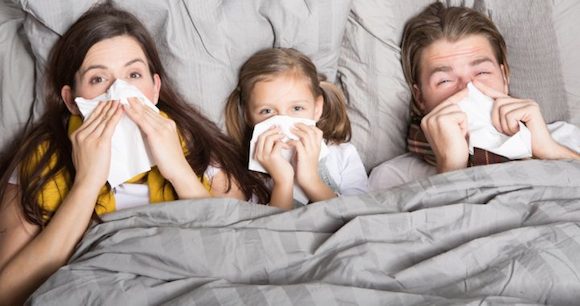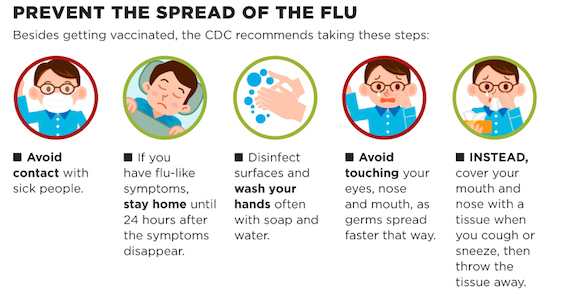CENTER FOR DISEASE CONTROL & PREVENTION: Intensified Flu Activity Now Pandemic In U.S.
By Arvind M. Dhople, Ph.D., Professor Emeritus, Florida Tech // February 3, 2018
U.S. Influenza Activity Highest Since 2003

BREVARD COUNTY, FLORIDA – During the current northern hemisphere’s winter, seasonal influenza (flu) activity has become worrisome.
Influenza is a contagious respiratory illness caused by an influenza virus. Most people who get the flu will have mild illness, will not need medical care or antiviral drugs, and will recover in less than two weeks. However, some people are more likely to get flu complications that can result in hospitalization and sometimes death.
U.S. Influenza Activity Highest Since 2003
According to the Centers for Disease Control and Prevention (CDC), widespread influenza activity is affecting the entire continental USA, Alaska and Puerto Rico, (only “local activity” in Hawaii) for the first time in 13 years, and this year’s season might well be severe.
According to CDC data, for the week ending January 13, the proportion of people seeing their health care provider for influenza-like illness (ILI) was 6.3%, which is above the national baseline of 2.2% and is the highest ILI percentage recorded since the 2003-2004 season.
CDC data also shows 8,990 laboratory-confirmed influenza-associated hospitalizations reported since October 2017 through the Influenza Hospitalization Network (FluSurv-NET), a population-based surveillance network for laboratory-confirmed influenza-associated hospitalizations. This translates to a cumulative overall rate of 31.5 hospitalizations per 100,000 people in the United States.

The highest hospitalization rates are among people 65 years and older (136.5 per 100,000), followed by adults aged 50-64 years (33.2 per 100,000), and children younger than 5 years (22.8 per 100,000). During most seasons, children younger than 5 years and adults 65 years and older have the highest hospitalization rates.
Flu Can Kill
The flu kills more people annually in the U.S. than auto accidents. According to the CDC, about 36,000 people a year die in the United States from complications of the flu, though the range varies greatly each year.
Already nearly 30 children in the U.S., two of whom were in Florida, have died from complications of the flu. Pregnant women, the elderly, young children and people with other underlying health problems are at much greater risk of suffering the worst flu symptoms—which can lead to hospitalization and death.
Vaccine Not Perfect, But Highly Recommended
There are two main types of influenza virus: Types A and B. The influenza A and B viruses that routinely spread in human (human influenza viruses) are responsible for seasonal flu epidemics each year. Influenza A viruses can be broken down into sub-types depending on the genes that make up the surface proteins. Over the course of a flu season, different types (A & B) and subtypes of influenza circulate and cause illness.
Influenza A H3N2 and B viruses account for the majority of influenza globally, and it is known that the H3N2 virus mutates at a faster rate than other types of viruses, which may result in less consistent vaccine protection.

CDC Director Dr. Brenda Fitzgerald said, “Influenza A, H3N2, has been the most common strain of flu virus reported this year. While our flu vaccines are far from perfect, they are the best way to prevent getting sick from the flu and one of the safest, most vetted and most studied vaccinations there is.”
Educate Yourself on Ways to Prevent Flu
This unusual seasonal influenza outbreak is a wake-up call to revisit influenza control strategies. More traditional public health precautions need to be reasserted. The CDC website explains several frequently forgotten or ignored everyday preventive actions that are aimed at limiting the spread of the disease. These include trying to avoid close contact with sick people, limiting contact with others while sick (by staying home for at least 24 hours after flu-like symptoms appeared if needed), covering one’s nose and mouth with a tissue while coughing or sneezing and throwing the tissue in the trash after use, keeping hands clean by regular washing with soap and water, avoiding touching mouth, nose, and eyes, and cleaning and disinfecting surfaces.

Influenza accounts for about 600,000 seasonal influenza-associated respiratory deaths annually worldwide. That systems are struggling to cope with seasonal influenza bodes poorly in the event of a virulent flu pandemic a century after the influenza pandemic of 1918.
For the 2017-2018 flu season, the Advisory Committee on Immunization Practices (ACIP) recommends annual influenza vaccination for everyone 6 months and older. Vaccination remains the most effective method for prevention and control of infection, and, if you haven’t already been vaccinated, it’s not too late in the season to get your vaccination now.
Also, it is imperative that all health professionals are laser-focused on implementing known influenza prevention strategies to combat this persistent global health threat.

ABOUT THE AUTHOR
Dr. Arvind Dhople graduated from the University of Bombay and then joined Johns Hopkins University School of Public Health, first as a postdoctoral fellow and then Asst. Professor. In 1980, he joined Florida Tech as a Professor and Director of their Infectious Diseases Lab. His specialty is microbial biochemistry and he performed research in leprosy and tuberculosis. He is a Fellow of the American Academy of Microbiology and has published nearly 150 articles in peer-reviewed journals. He has also served as an advisor to the World Health Organization, National Institutes of Health, German Leprosy Relief Association, and the Bill and Melinda Gates Foundation. Currently, he is Professor Emeritus at Florida Tech and a free-lance writer.
CLICK HERE FOR BREVARD COUNTY NEWS














